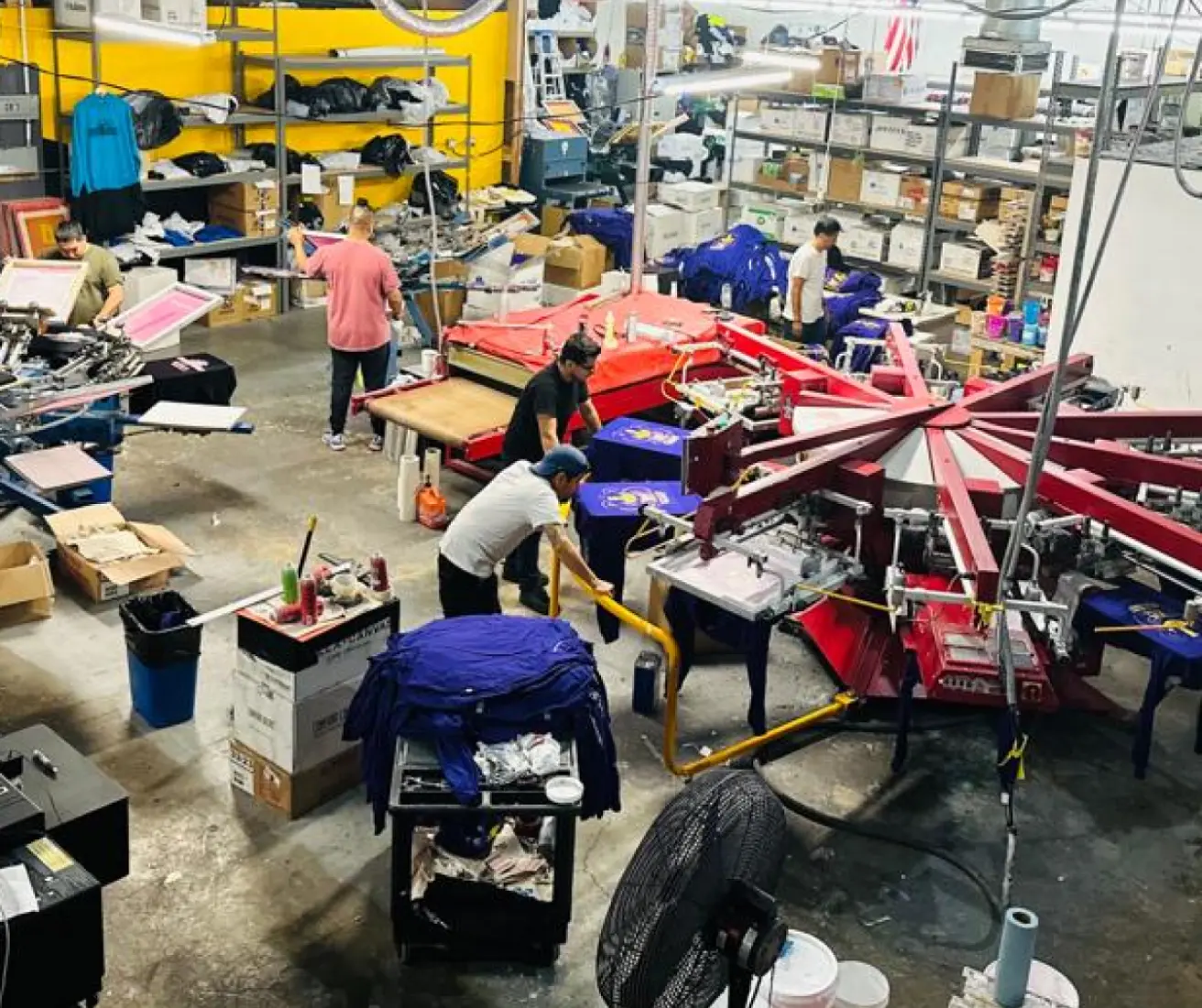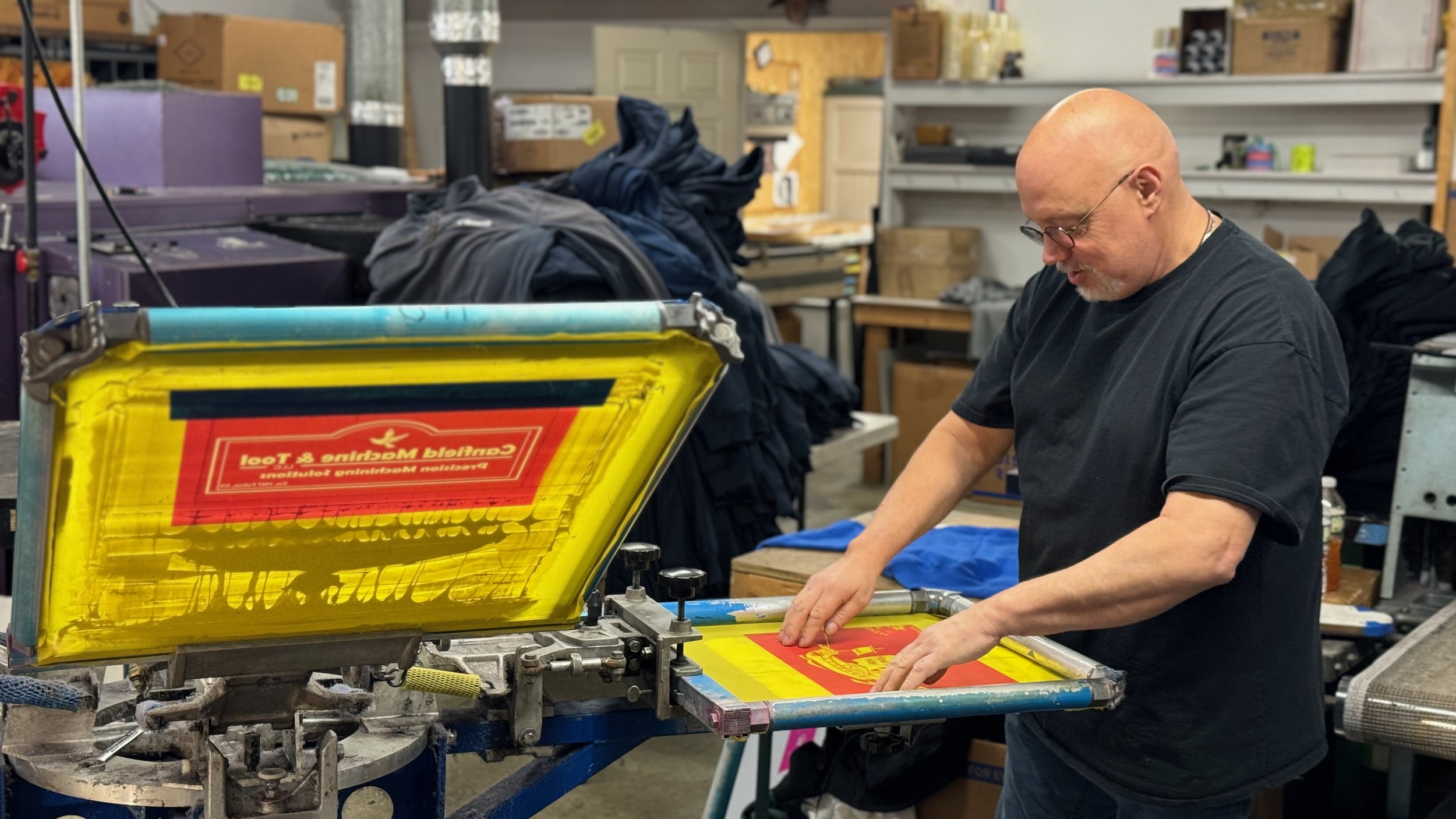Artistic Silk Screen Printing for Limited Edition Prints
Wiki Article
The Ultimate Display Printing Kit: Essential Devices for Effective Garment Printing
When it comes to screen printing, having the right tools can make all the difference. What concerning the inks and screens? You'll soon discover just how these parts function with each other to raise your printing video game.Comprehending Display Printing Essentials
When you engage yourself in screen printing, you'll find it's both an art and a science. This technique entails transferring ink through a mesh display onto material, producing vivid designs. You'll start by preparing your displays, which needs applying a light-sensitive solution. When dried out, you subject the display to UV light with your layout put on top, permitting you to produce a pattern.Next, you'll set up your printing station, straightening your display with the garment. Utilizing a squeegee, you'll press the ink with the display, guaranteeing even protection. The appeal of display printing lies in its adaptability; whether you're publishing bold graphics or detailed patterns, the procedure stays the very same.
As you practice, you'll learn about ink types, drying out times, and color blending. Each print is an opportunity to improve your method and share your creative thinking, making screen publishing a gratifying undertaking for any individual enthusiastic regarding design.
Necessary Components of the Display Printing Set
To begin with screen printing, you need to comprehend the crucial parts of your kit. You'll intend to familiarize yourself with the standard equipment, the kinds of inks and solutions you'll utilize, and the devices for application. Each component plays a vital role in achieving high-quality prints on your garments.Standard Equipment Overview
A well-appointed display printing kit is crucial for any individual looking to develop stunning garment styles. Start with a strong display printing framework, which holds your mesh tightly for specific printing. You'll likewise require a squeegee to press ink with the mesh onto your textile. Don't fail to remember the exposure unit or light resource, essential for moving your layout onto the screen. A washout station aids you clean screens after use, guaranteeing they're ready for your next project. Finally, spend in a registration system to straighten numerous shades properly. With these essential elements, you'll have a solid structure for your display printing journey and can focus on bringing your creative visions to life.Solutions and inks
After gathering the basic devices, your following emphasis ought to be on emulsions and inks, which play an important function in accomplishing durable and lively prints. When choosing inks, take into consideration water-based, plastisol, or discharge inks based on the material kind and preferred surface. Water-based inks are soft and environment-friendly on garments, while plastisol supplies sturdiness and intense shades.Solutions, on the other hand, are necessary for producing your screens. They assist establish the pattern required for printing - custom screen printing. You'll want to select a high-quality solution that matches your ink type and exposure approach. Keep in mind to keep emulsions and inks properly to keep their effectiveness. With the appropriate choices, you'll establish the structure for sensational, professional-grade prints.
Devices for Application

Picking the Right Screens for Your Jobs
When you're selecting screens for your jobs, the mesh matter and framework product are vital elements to consider. A greater mesh count is fantastic for fine details, while the right frame material can boost durability and stability. Comprehending these components will certainly help you accomplish the most effective lead to your screen printing endeavors.Screen Mesh Count
Selecting the best screen mesh matter is crucial to achieving the wanted results in your display printing projects. The mesh count refers to the number of threads per inch in the display, influencing just how much ink gets transferred onto your garment. Constantly think about the kind of ink and fabric you're making use of, as these aspects affect the mesh count choice.Frame Material Options
The display structure material you select plays a considerable duty in the top quality of your prints. You've obtained a couple of choices to assess, each with its benefits. Aluminum frames are light-weight, sturdy, and immune to corrosion, making them excellent for long-lasting usage. They provide superb stress, ensuring crisp prints. On the other hand, wood frames are extra traditional and can be a lot more inexpensive, however they're heavier and might warp gradually. If you're just beginning, you could favor light weight aluminum for its reliability. For bigger projects, pick frames that can hold up against the tension required for great details. Eventually, choose a product that fits your operations and budget while ensuring your prints appear looking sharp and expert.Choosing Inks for Different Fabrics
Exactly how do you assure your display printing layouts look vibrant and last on numerous materials? Picking the right ink is useful link vital. If you're publishing on polyester or artificial blends, think about making use of plastisol inks.Don't forget concerning specialty inks like discharge or metal inks. Release inks can get rid of color from material, leaving a soft print, while metallic inks add a glossy finish that stands apart. Constantly test your inks on the certain material prior to dedicating to a big run; this aids you assess color vibrancy and sturdiness.
Lastly, bear in mind the textile's weight and texture. Selecting the appropriate ink for every textile kind will guarantee that your layouts not only look terrific but also hold up against the examination of time.
The Importance of Mops in Printing
Mops play an important role in attaining top notch prints in screen printing. They're your main tool for transferring ink via the stencil onto the fabric, and the appropriate squeegee can make all the distinction. When you apply constant stress with a squeegee, you assure an also distribution of ink, reducing the chances of irregular or blotchy prints.Selecting the best durometer or solidity of your squeegee is essential, as it impacts just how much ink is drawn via the mesh. A softer squeegee is excellent for thorough designs, while a firmer one works well for vibrant graphics. Furthermore, the size of the squeegee ought to match your screen size to optimize your printing process.
Requiring time to understand your strategy with the squeegee will cause cleaner, sharper prints. Do not undervalue this essential device-- get to understand it, and you'll boost your screen printing game.
Preparing Your Artwork and Emulsion
Achieving excellent prints begins long prior to you select up your squeegee. When you're delighted with the layout, print it on openness film, maintaining in mind that the darker the picture, the better it blocks light throughout exposure.Use it evenly to your screen in a dimly lit location to prevent early exposure. When your screen is prepared, reveal it to UV light according to your solution's guidelines (custom screen printing).
After rinsing the unexposed solution, allow the display completely dry completely. With your art work and emulsion all set, you're established for the printing procedure!
Maintenance Tips for Lasting Tools
Although it might seem tiresome, regular maintenance of your display printing devices can substantially prolong their lifespan and warranty consistent outcomes. Beginning by cleansing your displays instantly after use.For mops, clean the blade after each use to stop ink from drying on it. Consistently look for nicks or damage and change them as needed. Don't forget your direct exposure system-- tidy the glass surface consistently to validate suitable light exposure.

Frequently Asked Inquiries
Can I Evaluate Print on Dark Colored Fabrics?
Yes, you can screen print on dark tinted textiles! Just make use of an appropriate nontransparent ink developed for dark products.Just how Do I Clean My Screens After Printing?
To cleanse your displays after printing, you'll need a stress washer or hose to get rid of excess ink. Then, utilize a display cleaner or mild news detergent with a soft brush to scrub away residue. Wash extensively.What Safety and security Equipment Do I Required While Screen Printing?
When screen printing, you'll require handwear covers to safeguard your hands, a mask to avoid breathing in fumes, and safety and security goggles to protect your eyes from chemicals and inks. Being careful warranties a enjoyable and risk-free experience.Can I Utilize the Kit for Other Products Besides Textile?
Yes, you can utilize the package for various other products besides material. It works well on surfaces like timber, paper, and plastic. Simply make sure the ink and strategies fit the material you select.
The length of time Does It Take for Ink to Treat?
Ink usually takes concerning 24 hours to treat totally, however it can vary based on the type and density. You'll wish to inspect the producer's standards for certain treating Recommended Reading times to guarantee perfect results.Making use of a squeegee, you'll press the ink with the screen, ensuring also insurance coverage. You'll require a reputable squeegee, which helps uniformly disperse ink across your screen.Picking the best display mesh count is essential to achieving the wanted outcomes in your display printing jobs. The mesh count refers to the number of threads per inch in the display, impacting how much ink gets transferred onto your garment.To cleanse your displays after printing, you'll require a stress washing machine or hose to eliminate excess ink.
Report this wiki page